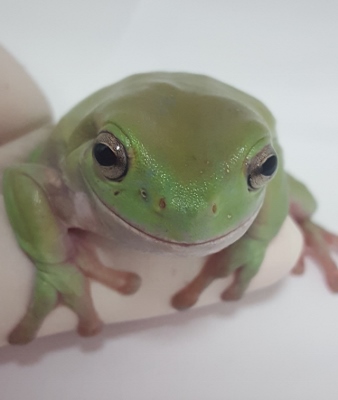
It’s the last day of November and that means today is the last day the spotlight is on the White’s tree frog as our Animal of the Month. We hope you were following us on Twitter @ExoticPetVets throughout November as we tweeted about these nocturnal frogs who always look like they’re smiling. If you missed any of our tweets, we have a summary of them for you right here. Did you know?:
- White’s tree frog (Litoria caerulea) is native to Australia and New Guinea. There are reportedly introduced feral populations in New Zealand and the U.S.
- White’s tree frog is named after John White, an Irish surgeon who was appointed as Surgeon-General to New South Wales in Australia in the 18th Century.
- While in Australia, John White first described White’s tree frog in 1790 in his book “A Journal of a Voyage to New South Wales.”
- White’s tree frog is also commonly known as the green tree frog or the Australian green tree frog.
- One seemingly unflattering nickname White’s tree frog has is dumpy tree frog, supposedly because of his fat rolls and stout body shape.
- White’s tree frogs also have a nickname with a more positive connotation – the smiling tree frog – because their mouths make it look like they’re smiling.
- Compared with other frog species from Australia, White’s tree frogs are quite heavy and large.
- Fully grown White’s tree frogs range in size between 7-11.5 cms (3-4.5”) in length. Females are larger than the males.
- White’s tree frogs have either a green or blueish-green back. They also have gold or white spots scattered along their sides and sometimes on their backs.
- White’s tree frogs have golden-coloured eyes with a horizontal pupil and a ridge of fat over each eye, giving the White’s tree frog a distinct and sleepy appearance.
- The skin of the White’s tree frog has three layers of pigment which allows them to change colour from green to brown.
- Light and temperature are the biggest factors that influence the White’s tree frog’s colour change. They typically change colour as the seasons change.
- In cooler temperatures, White’s tree frogs will sport darker colours to absorb heat. Conversely, in warmer weather, they will become lighter in colour to reflect heat.
- As their name suggests, wild White’s tree frogs live in trees. They access water via rainwater which collects on leaves and in tree crevices.
- White’s tree frogs have flat toes that help them live an arboreal life. Their toes have a sticky surface consisting of interconnecting discs which squeeze together allowing them to grip surfaces for climbing and jumping.
- White’s tree frogs have adapted to both wet and dry habitats depending on the season. Some researchers suggest they can regulate their body temperature based on how much water is evaporated through their skin.
- Because White’s tree frogs keep their skin moist, they regularly shed their skin as a way to protect themselves against bacteria which can make them sick.
- As the White’s tree frog sheds his skin, he eats it because there are nutrients in the skin that are good for him.
- When shedding his skin, the White’s tree frog will alternately crunch and puff up his body to loosen his skin. He will also look like he is yawning or regurgitating as he eats his own skin.
- White’s tree frogs are mostly insectivores, meaning the majority of their diet consists of bugs and spiders. But they will occasionally eat small mammals or frogs.
- White’s tree frogs are nocturnal, which means they are active at night. They can be found in or near people’s homes hunting for insects who are attracted to the lights of modern living.
- White’s tree frogs also venture into areas where people live and work during the dry summer months to seek moisture from places such as reservoirs and bathrooms.
- White’s tree frogs can live to about 15 years in the wild, but are known to live up to 20 years in captivity.
- The Smithsonian’s National Zoo and Conservation Biology Institute reports there is one recorded case of a captive White’s tree frog living to an age of 21 years.


Hi! Thank you for this. Very interesting. Only 2 or 3 things I did not know about my 6 frogs. I have had 1 for almost 10 years so far!